The beauty of golf is its accessibility to individuals of all ages. For seniors, golf offers not just physical exercise but also mental stimulation and social interaction. However, as age advances, maintaining the flexibility and power required for an effective senior golf swing can become challenging. One of the crucial aspects of a successful golf swing, especially for seniors, is the shoulder turn. In this comprehensive guide, we will delve into techniques and exercises specifically designed to enhance and refine the shoulder turn for senior golfers, ensuring they can continue to enjoy the game they love while maximizing their performance on the course.
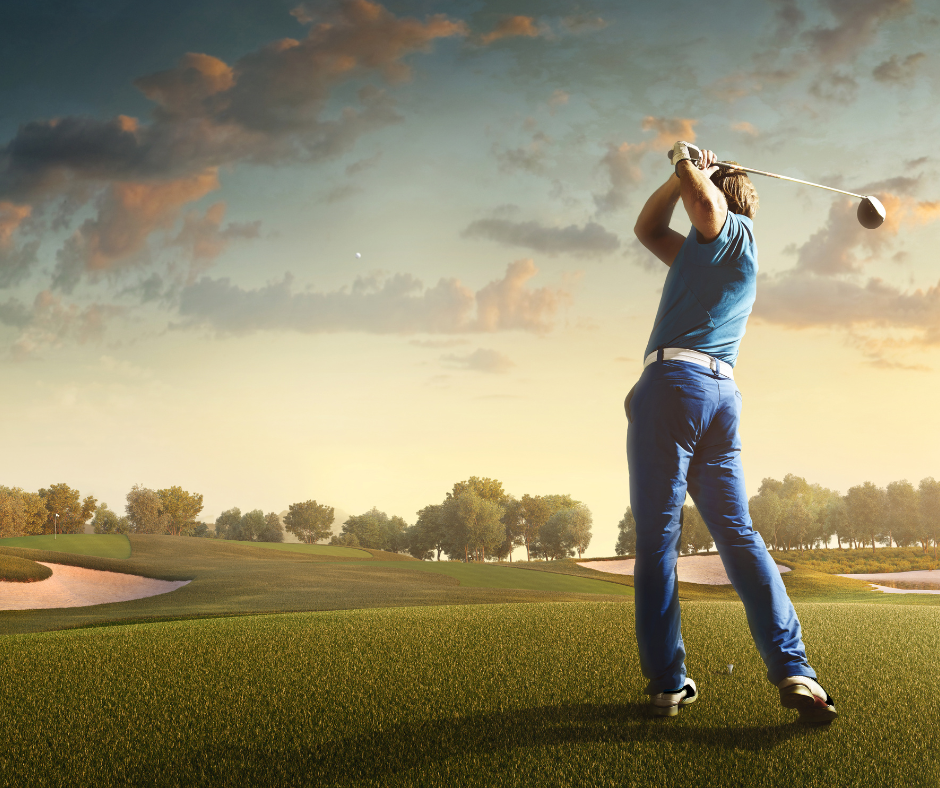
Enhance and Refine The Shoulder Turn in Golf
Understanding the Importance of Shoulder Turn:
The shoulder turn is a fundamental component of the golf swing, dictating the power, accuracy, and consistency of the shot. For senior golfers, a proper shoulder turn becomes even more critical due to the natural decrease in flexibility and strength that comes with age. A well-executed shoulder turn allows senior golfers to generate more clubhead speed, leading to longer drives and better ball control. Moreover, it helps in maintaining balance throughout the swing, reducing the risk of injuries and improving overall performance on the course.
Techniques to Enhance Shoulder Turn:
- Flexibility and Warm-up:
As we age, our bodies tend to become less flexible, making it harder to achieve a full and effective shoulder turn. That’s why it is essential for senior golfers to focus on improving flexibility and incorporating a thorough warm-up routine before hitting the course. Stretching exercises that target the shoulders, back, and torso can significantly enhance range of motion and allow for a more complete turn during the swing. - Proper Setup: A good shoulder turn begins with a solid setup. Ensure that your feet are shoulder-width apart, knees slightly flexed, and your weight evenly distributed between both feet. Position the golf ball slightly forward in your stance, allowing for a more natural rotation during the backswing.
- Maintain Posture: Maintaining proper posture throughout the swing is crucial for an effective shoulder turn. Keep your spine straight and tilt forward from your hips. Avoid excessive bending of the knees or slumping of the shoulders, as this can restrict your range of motion.
- Focus on Rotation: The key to a powerful shoulder turn is rotation, not lateral movement. Focus on turning your shoulders away from the target as you initiate the backswing, allowing your lead shoulder to rotate under your chin. Aim for a full 90-degree turn with your shoulders to maximize the coil and potential energy stored in your body.

Establish a Wide Arc:
During the backswing, aim to create a wide arc with your arms. Allow your lead arm (left arm for right-handed golfers) to extend fully, ensuring that it remains relatively straight. This extension maximizes the rotation of your shoulders and increases your swing’s potential power. Focus on maintaining a connection between your lead arm and chest throughout the swing to facilitate a wide and efficient turn.
- Use Your Hips: A proper shoulder turn is closely linked to the rotation of the hips. Engage your core muscles and initiate the backswing by turning your hips away from the target simultaneously with your shoulders. This synchronized movement creates torque and increases the potential for a more explosive downswing.
- Maintain Balance: While it’s essential to achieve a full shoulder turn, it’s equally important to maintain balance throughout the swing. Avoid swaying or tilting excessively, as this can lead to inconsistency and loss of power. Focus on staying centered over the ball and feel the weight transfer from your back foot to your front foot as you rotate.
- Practice Tempo and Rhythm:
Developing an effective shoulder turn requires mastering the tempo and rhythm of your swing. Experiment with different tempos to find the one that allows you to maintain balance, generate power, and strike the ball with precision. Practice drills that focus on synchronized body movements and the timing of the shoulder turn. Over time, you will discover the tempo that suits your swing style and maximizes your performance. - Strength and Conditioning:
Strength and conditioning exercises designed specifically for golf can improve your overall fitness and contribute to a more powerful shoulder turn. Focus on exercises that target the muscles in your core, upper body, and legs. Strengthening these areas will support your body during the swing and enhance your ability to rotate your shoulders effectively. - Seek Professional Instruction:
Working with a golf professional can significantly accelerate your progress in refining your shoulder turn. They can provide personalized guidance, analyze your swing mechanics, and offer specific drills and exercises tailored to your needs. Professional instruction ensures that you learn correct techniques and avoid developing bad habits that may hinder your shoulder turn.
Seniors aged 51 and above may notice a decrease in swing speed because their flexibility and muscle strength tend to decline. On average, seniors’ swing speed can range from 70 to 85 mph.
Always consult your physician when you have changes in physical activities
Exercises to Improve Shoulder Turn:
- Shoulder Mobility Exercises: Incorporate shoulder mobility exercises into your regular fitness routine to improve flexibility and range of motion. Exercises such as shoulder circles, arm swings, and shoulder stretches can help loosen tight muscles and joints, allowing for a more fluid shoulder turn during the golf swing.
- Thoracic Spine Mobility Drills: The thoracic spine plays a crucial role in facilitating a proper shoulder turn. Perform exercises such as thoracic spine rotations using a foam roller or a mobility ball to mobilize the spine and improve rotational flexibility.
- Resistance Band Drills: Use resistance bands to strengthen the muscles involved in the shoulder turn, including the rotator cuff muscles and the muscles of the upper back. Exercises such as resisted shoulder rotations and band pulls can help improve muscle activation and enhance the power and stability of your golf swing.
- Yoga and Pilates: Incorporating yoga or Pilates into your fitness routine can provide numerous benefits for senior golfers, including improved flexibility, core strength, and body awareness. Focus on poses and exercises that target the shoulders, spine, and hips, such as downward dog, cat-cow stretch, and spinal twists.
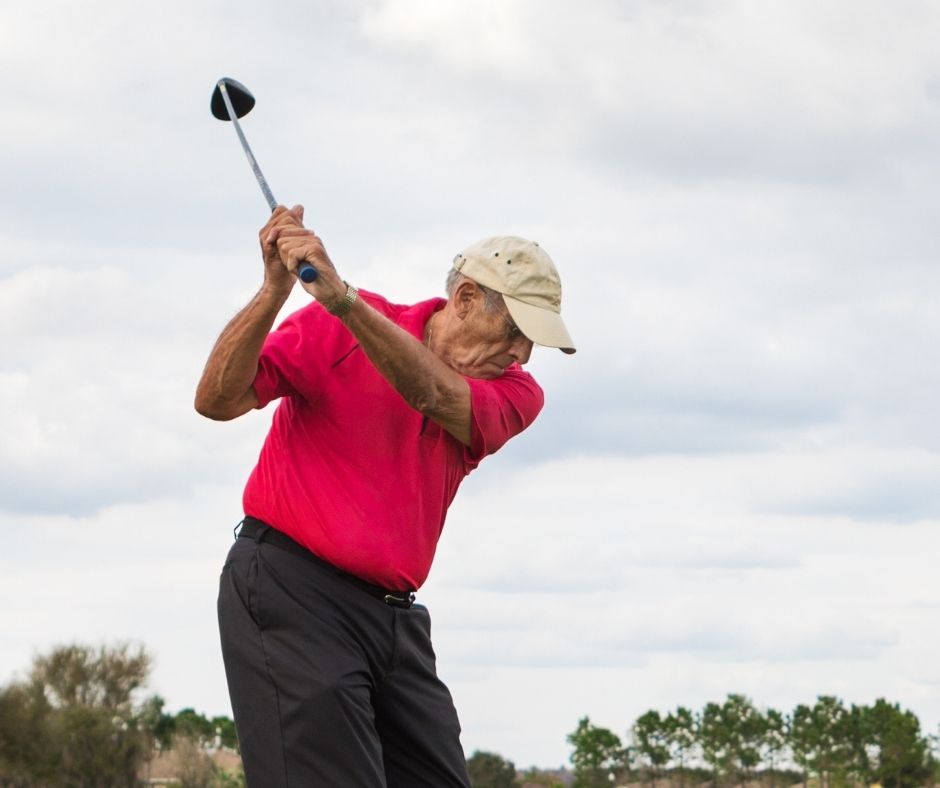
Golf-Specific Drills: Practice golf-specific drills that focus on enhancing the shoulder turn. For example, the “one-arm drill” involves swinging the club with only one arm, focusing on rotating the shoulders and maintaining balance throughout the swing. Another effective drill is the “split grip drill,” where you hold the club with your hands separated on the grip, promoting a wider and more fluid shoulder turn.
Other tips for Shoulder Turn in the Golf Swing:
- Focus on the backswing:
During the backswing, concentrate on initiating the turn from your shoulders rather than relying solely on your arms. Engage the muscles in your upper body and feel the rotation from the core, which will encourage a more powerful and efficient turn. - Coil and resistance:
As you complete the backswing, aim to create a coiled position with your upper body. This coiling effect generates torque, which can then be released during the downswing, adding distance and accuracy to your shots. - Practice drills:
Incorporate specific drills into your practice sessions that focus on improving your shoulder turn. For instance, use a mirror to monitor your shoulder rotation or practice half swings to emphasize the correct technique.
A well-executed shoulder turn is essential for senior golfers looking to maintain or improve their performance on the course. By implementing the techniques and exercises outlined in this guide, senior golfers can enhance their shoulder turn, increase clubhead speed, and achieve greater consistency and accuracy in their shots. Remember to focus on proper setup, rotation, and balance, and incorporate specific drills and exercises to improve flexibility, strength, and mobility. With dedication and practice, senior golfers can enjoy a more powerful and efficient golf swing, allowing them to continue enjoying the game for years to come.
All Arms Swing Golf Swing Error by Golf Distillery
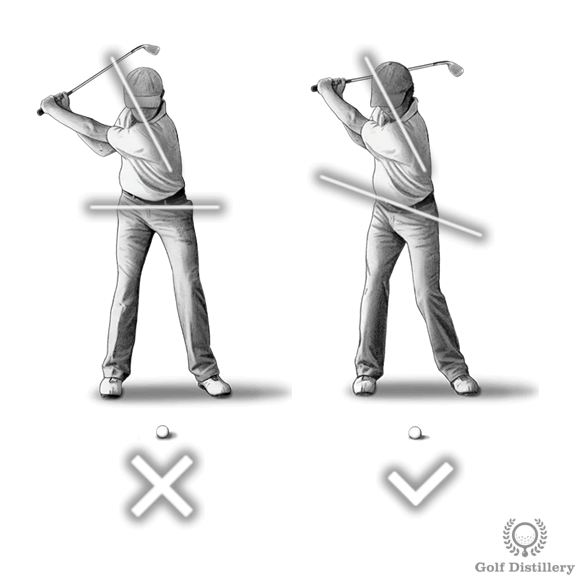
A golf swing said to be an “all arms” swing is one that features movements almost exclusively limited to that of the arms. Indeed, such a swing error foregoes soliciting the hips, barely or at all. This is in contrast to a better swing that features a healthy amount of hips and shoulder turn, both coiling during the backswing and uncoiling during the downswing.
Problems Associated with an All-Arms Swing
Limited Power, Distance
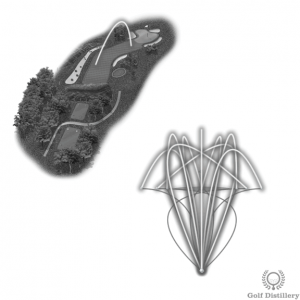
The main issue with an all-arm swing is that it fails to generate much in the way of power. Indeed, rather that creating and storing power while the hips are coiling back during the backswing, the failure to engage them will limit the amount of energy that can be transferred onto the ball.
This means that you will hit your next shot with a longer club than necessary, or that you will hit shots onto greens using a longer club.
Mistiming Issues will lead to Wide Shot Scatter
Another issue caused by lazily engaging your hips is that it leads to mistiming issues. This can occur when the hips were not solicited for one swing step but were for another. For example, let’s say you did indeed coil your hips during the backswing but are only swinging with your arms on the downswing.
Failure to bringing your hips back towards impact will throw your whole swing into an unsynchronized mess. Alternatively, let’s assume you did not coil your hips back during the backswing but are correctly initiating the downswing by uncoiling your hips.
The result will see your hips thrown out of position at impact, and will have for effect a high unpredictability in your shots and a wide shot scatter.
How to Stop Swinging Only with your Arms
Make Sure to Rotate your Upper Body
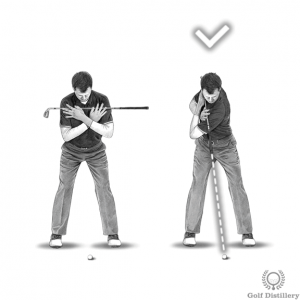
The problem with an all-arms swing is that it doesn’t involve the upper body. As the swing error name suggests, it mainly involves using the arms to swing at the ball. This results in powerless effort, with the ball not going at nearly the full distance it should.
In order to make sure you are involving your entire body in your golf swing use this drill. Place the club in front of your chest with your hands and see that the grip end of the club points directly ahead, at the target. Perform a mock backswing and make sure that the end of your club points at the ball when you reach what would be your top of the swing.
Reaching this position will only be possible if you are indeed rotating your upper body on top of your hips, with your shoulders – not your arms – doing most of the work. Making sure to involve your body this way will help you create effortless power – rather than the powerless effort you were doing while using your arms alone.
Focus on Transferring Weight
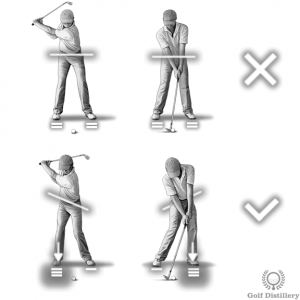
One of the ways to help make sure your hips are solicited at all – and that you are not only swinging with your arms – is to engage your hips early in the swing.
Making sure your hips are rotating back will shield from at least half of the problem with an all-arms swing. This can be done by thinking and focusing about properly shifting your weight during the backswing.
Indeed, weight can only really be transferred onto your right–back – foot during the backswing if your hips are rotating. If they are not, most of your weight will still be evenly split among your two feet at the top of the swing.
If weight has been transferred back correctly then the next step will be to focus on transferring the weight onto your left – front – foot at your head into impact. A process that can only truly be done if your hips are uncoiling correctly and are not staying back where they were at the top of the swing.
- Mental Strategies to Help Senior Golfers Play Better
 ⛳️ Golf is more than a swing—it’s a mental game. For senior golfers, sharpening your focus, building confidence, and staying calm under pressure can make all the difference.
⛳️ Golf is more than a swing—it’s a mental game. For senior golfers, sharpening your focus, building confidence, and staying calm under pressure can make all the difference. - Golf Spectator Etiquette: How to Enjoy the Game Without Distracting the Pros (With Lessons from the 2025 Ryder Cup)
 Learn golf spectator etiquette with senior-friendly tips. Lessons from the 2025 Ryder Cup show why respect keeps the game enjoyable.
Learn golf spectator etiquette with senior-friendly tips. Lessons from the 2025 Ryder Cup show why respect keeps the game enjoyable. - Forward Tees: The Distinction of Being a Super Senior
 Experiencing something peculiar and delightful has been my reality in recent years. It’s been quite a transformation for me—I’ve become what they call a “super senior” golfer. Now, let me clarify,
Experiencing something peculiar and delightful has been my reality in recent years. It’s been quite a transformation for me—I’ve become what they call a “super senior” golfer. Now, let me clarify, - Best Golf Tips for Senior Golfers – Expanded Guide
 Whether you’ve been playing golf for decades or have only recently taken up the sport, being a senior golfer comes with its own set of challenges and opportunities.
Whether you’ve been playing golf for decades or have only recently taken up the sport, being a senior golfer comes with its own set of challenges and opportunities. - Effective Ways to Address Smoking on the Golf Course
 Smoking—especially cigar smoking—on the golf course is a long-standing tradition for some players, but it can also create tension within a group when not everyone enjoys or tolerates smoke. Addressing smokers in your group the right way requires a balance of respect, tact, and awareness of both etiquette and course policies. Smoking on the Golf… Read more: Effective Ways to Address Smoking on the Golf Course
Smoking—especially cigar smoking—on the golf course is a long-standing tradition for some players, but it can also create tension within a group when not everyone enjoys or tolerates smoke. Addressing smokers in your group the right way requires a balance of respect, tact, and awareness of both etiquette and course policies. Smoking on the Golf… Read more: Effective Ways to Address Smoking on the Golf Course
